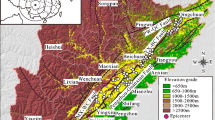Abstract
Numerous earthquake-induced landslides occurred in the Longmenshan tectonic belt associated with the 12th May 2008 Wenchuan earthquake where the vertical acceleration was greater than the horizontal ground motion. Many of these landslides originated in the steep mountain terrain which amplified the effect of the ground shaking. Three typical landslides are discussed: the Niujuangou sturzstrom, the Chengxi rock slide and the 1,100 million m3 Daguangbao rock slide. Having discussed the individual slides and some previously published models, a mechanism to explain both the very fast velocity of the slides and their long run-out distance is proposed, taking into account aerodynamic principles. The model postulates that air trapped in the steep-sided valley by the collapsing rock mass forms a “cushion-effect” on which the debris moves.
Résumé
De nombreux glissements ont été déclenchés par le séisme de Wenchuan le 12 mai 2008 dans les montagnes de Longmenshan où l’accélération verticale a été plus grande que l’accélération horizontale. Beaucoup de ces glissements se sont produits sur des pentes raides qui ont amplifié les effets du mouvement sismique. Trois glissements typiques sont présentés: le mouvement gravitaire rapide de Niujuangou, le glissement rocheux de Chengxi et le glissement rocheux de Daguangbao de 1100 millions de m3. Après l’analyse de chacun de ces glissements et de plusieurs modèles précédemment présentés à leur sujet, un mécanisme permettant d’expliquer à la fois la très rapide vitesse de déplacement des glissements et leur longue distance de déplacement est proposé, prenant en compte des principes d’aérodynamique. Le modèle suppose que l’air, emprisonné dans la vallée aux pentes raides par les masses rocheuses en glissement, a formé un coussin d’air sur lequel les roches broyées se sont déplacées.





























Similar content being viewed by others
References
Battis J (1981) Regional modification of acceleration attenuation functions. Bull Seismol Soc Am 71(4):1309–1321
Chandra U (1979) Attenuation of intensities in the United States. Bull Seismol Soc Am 69(6):2003–2024
Chen H, Hawkins A (2010) Relationship between earthquake disturbance, tropical rainstorms and debris movement: an overview from Taiwan. Bull Eng Geol Environ 68(2):181–186
Coller CJ, Elnashai AS (2001) A procedure for combining vertical and horizontal seismic action effects. J Earthquake Eng 5(4):521–539
Cruden DM, Varnes DJ (1996) Landslide types and processes. In: Turner AK, Schuster RL (eds) Landslides investigation and mitigation: Transportation Research Board, US National Research Council, Special Report 247, Washington, DC, pp 36–75
Elnashai AS, Papazoglou AJ (1997) Procedure and spectra for analysis of RC structures subjected to strong vertical earthquake loads. J Earthquake Eng 1(1):121–155
Heim A (1932) Bergsturz und Menschenleben. Fretz & Wasmuth, Ziirich
Hsu KJ (1975) Catastrophic debris streams (Sturzstorms) generated by rockfalls. Geol Soc Am Bull 86(1):129–140
Hu Y (2005) Earthquake Engineering[M]. Seismologic Press, Beijing, pp 109–114 (in Chinese)
Huang R, Pei X, Li T (2008) Basic Characteristics and formation mechanism of the largest scale landslide at Daguangbao occurred during the Wenchuan earthquake. Chinese J Eng Geol 16(6):730–741
Hungr O (2004) Dynamics of rapid landslides. In: Kyoji S (eds) Landslides in progress. Springer, Heidelberg, pp 47–57
Jiang Y et al (1992) Rockslide-debris flow of the Xikou, Huaying, Sichuan. Geol Hazard Environ Prot 3(2):51–58
Jing D et al (1988) The Tangyanguang landslide at the Zexi reservoir. In: Researches on the selected cases of landslides in China. Science Press, Beijing, pp 301–305
Liu W (2002) Study on the characteristics of huge scale super highspeed long distance landslide chain in Yigong, Tibet. Chin J Geol Hazard Control 13(3):9–18
Plafker G (1978) Nevados Huascaran avalanche. In: Voight B. Landslide and avalaches, Natural Phenomena [M], vol 1. New York, Elsevier, pp 1–826
Qian P (1983) On the vertical seismic load. Earthquake Eng Eng Vib 3(2):44–54 (in Chinese)
Qian P (2002) Vertical and horizontal seismic load of water tower. Build Sci Res Sichuan 28(3):66–67 (in Chinese)
Sassa K et al (1996) Earthquake-induced-landslides: distribution, motion and mechanisms. Soil and foundations, (Special issue for the great Hanshin earthquake disasters): pp 53–641
Scheidegger AE (1973) On the prediction of the reach and velocity of catastrophic landslides. Rock Mech 11:40
Seed HB (1968) Landslides during earthquakes due to soil fluidization. ASCE 94(SM5):1055–1122
Shreve RL (1968) Leaking and fluidization in air layer lubricated avalanches. Geol Soc Am Bull 79:653–657
Tang C (1991) A study on large-scale catastrophic landslide at Touzai gully of Zhaotong. Yun Geogr Environ Res 3(2):64–71
Wang Z (2008) A preliminary report on the great Wenchuan earthquake. Earthquake Eng Eng Vib 7(2):225–234
Xing A et al (2002) Study on wind tunnel testing of aero dynamic properties of high velocity landslide. J Tongji Univ 30(5):435–836 (in Chinese)
Xu J (1993) A brief discussion about slope movement with high velocity and long distance. Chin J Geol Hazards Control 4(4):1–6 (in Chinese)
Yin Y (2009) Landslide hazards triggered by the 2008 Wenchuan earthquake, Sichuan, China. Landslides 2009 6(2):139–152
Yu H, Wang D, Yang Y et al (2009) The preliminary analysis of strong ground motion records from the Ms8.0 Wenchuan earthquake[J]. J Earthquake Eng Eng Vib 29(1):1–13
Zhan Z et al (1986) Analysis on Saleshan Landslide. Mt Res 4(3):145–152
Acknowledgments
The authors would like to sincerely thank Mr. Min Wang, the Deputy Minister of MLR, Mr. Jianjun Jiang, the Director of Department of Environmental Geology of MLR, Mr. Guangqi Song, the Director of Department of Land and Resources of Sichuan Province, Mr. Chongrong Fan, the Deputy Director of Geological Prospecting Bureau of Sichuan Province, Prof. Runqiu Huang, the Vice President of Chengdu University of Technology and Mr. Jun Ding, the Director of Chengdu Center of China Geological Survey, for their support and help.
Author information
Authors and Affiliations
Corresponding author
Rights and permissions
About this article
Cite this article
Yin, Y., Zheng, W., Li, X. et al. Catastrophic landslides associated with the M8.0 Wenchuan earthquake. Bull Eng Geol Environ 70, 15–32 (2011). https://doi.org/10.1007/s10064-010-0334-7
Received:
Accepted:
Published:
Issue Date:
DOI: https://doi.org/10.1007/s10064-010-0334-7




